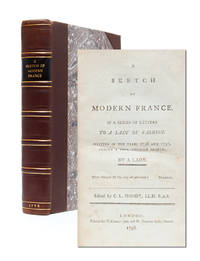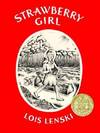
A Sketch of Modern France in a Series of Letters to a Lady of Fashion, Written in the Years 1796 and 1797..
by [Beaumont, Louise Elisa] A Lady
- Used
- near fine
- first
- Condition
- Near Fine
- Seller
-
Pasadena, California, United States
Payment Methods Accepted
About This Item
London: T. Cadell Jun. and W. Davies, 1798. First edition. Near Fine. Bound to style in modern half calf over modern boards, with morocco and gilt label to spine. Renewed endpapers. Measuring 210 x 125mm. Collating viii, 518, [2]: complete, including final leaf of adverts. Small paper flaw to margin of 509-510 not affecting text and faint dampstain to upper margin of preliminaries, else a pleasing and clean copy internally. ESCT reports 15 libraries with copies (8 of those in the U.S.), and it does not appear in the modern auction record. Currently this is the only copy on the market.
Notable for being an eyewitness account of Revolutionary France from the perspective of a woman, at a time when "British travellers to Paris were steeped in the highly emotional culture of sensibility...in pursuit of the picturesque" (Thompson). While Louise Elisa Beaumont had an interest in the beauty of French urban culture, the principle focus of her work was how the French people, their cultural institutions, and their city landscapes were being reshaped by "an earthquake on society."
An educated Englishwoman married to a Swiss author and illustrator, Beaumont kept a keen eye on how shifts in political thought affected art and antique markets -- and what these shifts implied about the violence and changing lifestyles that the French would be confronting longterm. "On the quays," she writes at one point, "I found that many valuable articles were now to be purchased for a mere trifle...articles that once decorated the apartments of their murdered or emigrated nobles." As she and her husband traveled the Continent to relocate to his native country, Beaumont reported what she saw to a female friend in a series of 31 letters that became the basis for this book. Because the British upperclasses had been frequent travelers to France prior to the Revolution, an account like Beuamont's could strike a deep chord, presenting to them a very different picture of the places that had for much of their lives been familiar. "My sensations on entering this capital of the French Republic I can but feebly describe...It is a new Paris...I could not but reflect that, which French delicacy and sentiment objected to the representation of murder in their tragical dramas, in the real tragedy of the revolution they have not manifested the least reluctance at seeing torrents of blood flow..." She reports on the blood stained Tuillieres Palace, and the rapid changes happening at the Luxembourg. And she recounts how Austrian prisoners of war are being held in Dijon.
Yet she also draws attention to how these social shifts, how wartime violence, affects women's lives. In Paris, while some women surge the streets hawking political pamphlets and war trophies, the nuns of St. Vincent, "young and handsome had totally given themselves to the care of attending the sick and the indigent." The sisters, though "the revolution had annihilated them as an order and deprived them of their possessions" turn their energies to assisting those so often affected by but forgotten in conflict. And outside the city, "the females of Breteuil, who, like the generality of their sex, when once irritated are not soon appeased" decide to respond to the occupation of their church by soldiers. To this end, they "sallied forth one fine morning, completely armed with female weapons such as spits brooks, sticks, and brickbats [to assail] the principal church door...In they rushed, and without further ceremony turned out those who were in it." A valuable and scarce example of a woman observing how revolution affects men and women, local and international communities.
ESTC T117774. Near Fine.
Notable for being an eyewitness account of Revolutionary France from the perspective of a woman, at a time when "British travellers to Paris were steeped in the highly emotional culture of sensibility...in pursuit of the picturesque" (Thompson). While Louise Elisa Beaumont had an interest in the beauty of French urban culture, the principle focus of her work was how the French people, their cultural institutions, and their city landscapes were being reshaped by "an earthquake on society."
An educated Englishwoman married to a Swiss author and illustrator, Beaumont kept a keen eye on how shifts in political thought affected art and antique markets -- and what these shifts implied about the violence and changing lifestyles that the French would be confronting longterm. "On the quays," she writes at one point, "I found that many valuable articles were now to be purchased for a mere trifle...articles that once decorated the apartments of their murdered or emigrated nobles." As she and her husband traveled the Continent to relocate to his native country, Beaumont reported what she saw to a female friend in a series of 31 letters that became the basis for this book. Because the British upperclasses had been frequent travelers to France prior to the Revolution, an account like Beuamont's could strike a deep chord, presenting to them a very different picture of the places that had for much of their lives been familiar. "My sensations on entering this capital of the French Republic I can but feebly describe...It is a new Paris...I could not but reflect that, which French delicacy and sentiment objected to the representation of murder in their tragical dramas, in the real tragedy of the revolution they have not manifested the least reluctance at seeing torrents of blood flow..." She reports on the blood stained Tuillieres Palace, and the rapid changes happening at the Luxembourg. And she recounts how Austrian prisoners of war are being held in Dijon.
Yet she also draws attention to how these social shifts, how wartime violence, affects women's lives. In Paris, while some women surge the streets hawking political pamphlets and war trophies, the nuns of St. Vincent, "young and handsome had totally given themselves to the care of attending the sick and the indigent." The sisters, though "the revolution had annihilated them as an order and deprived them of their possessions" turn their energies to assisting those so often affected by but forgotten in conflict. And outside the city, "the females of Breteuil, who, like the generality of their sex, when once irritated are not soon appeased" decide to respond to the occupation of their church by soldiers. To this end, they "sallied forth one fine morning, completely armed with female weapons such as spits brooks, sticks, and brickbats [to assail] the principal church door...In they rushed, and without further ceremony turned out those who were in it." A valuable and scarce example of a woman observing how revolution affects men and women, local and international communities.
ESTC T117774. Near Fine.
Reviews
(Log in or Create an Account first!)
Details
- Bookseller
- Whitmore Rare Books
(US)
- Bookseller's Inventory #
- 4195
- Title
- A Sketch of Modern France in a Series of Letters to a Lady of Fashion, Written in the Years 1796 and 1797..
- Author
- [Beaumont, Louise Elisa] A Lady
- Book Condition
- Used - Near Fine
- Quantity Available
- 1
- Edition
- First edition
- Publisher
- T. Cadell Jun. and W. Davies
- Place of Publication
- London
- Date Published
- 1798
Terms of Sale
Whitmore Rare Books
15 day return guarantee, with full refund if an item arrives damaged or not matching the description.
About the Seller
Whitmore Rare Books
Biblio member since 2009
Pasadena, California
About Whitmore Rare Books
We operate a retail shop in "Old Town" Pasadena open normal business hours Tuesday through Saturday.
Glossary
Some terminology that may be used in this description includes:
- Fine
- A book in fine condition exhibits no flaws. A fine condition book closely approaches As New condition, but may lack the...
- Morocco
- Morocco is a style of leather book binding that is usually made with goatskin, as it is durable and easy to dye. (see also...
- Calf
- Calf or calf hide is a common form of leather binding. Calf binding is naturally a light brown but there are ways to treat the...
- Spine
- The outer portion of a book which covers the actual binding. The spine usually faces outward when a book is placed on a shelf....
- New
- A new book is a book previously not circulated to a buyer. Although a new book is typically free of any faults or defects, "new"...
- First Edition
- In book collecting, the first edition is the earliest published form of a book. A book may have more than one first edition in...
- Gilt
- The decorative application of gold or gold coloring to a portion of a book on the spine, edges of the text block, or an inlay in...





